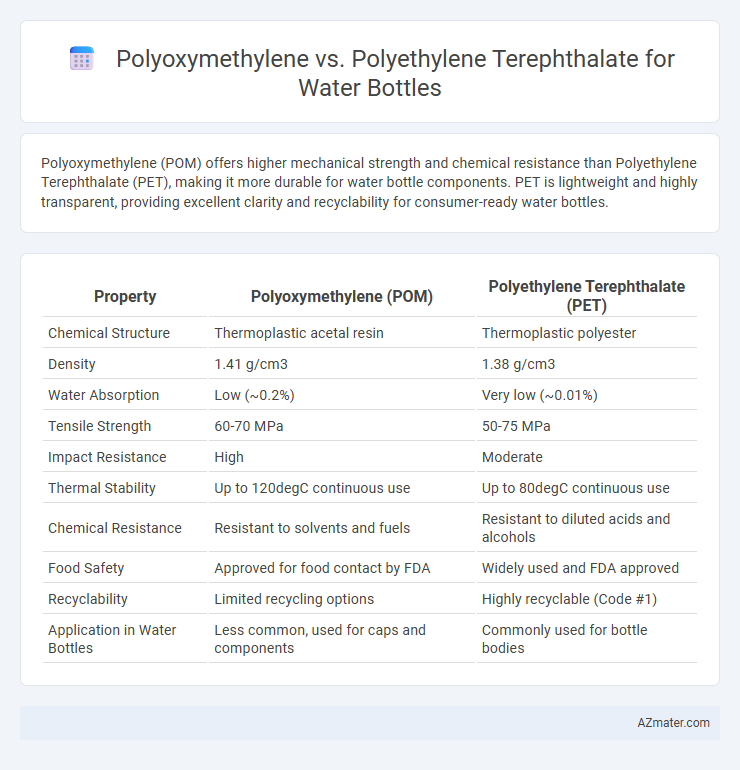Polyoxymethylene (POM) offers higher mechanical strength and chemical resistance than Polyethylene Terephthalate (PET), making it more durable for water bottle components. PET is lightweight and highly transparent, providing excellent clarity and recyclability for consumer-ready water bottles.
Table of Comparison
| Property | Polyoxymethylene (POM) | Polyethylene Terephthalate (PET) |
|---|---|---|
| Chemical Structure | Thermoplastic acetal resin | Thermoplastic polyester |
| Density | 1.41 g/cm3 | 1.38 g/cm3 |
| Water Absorption | Low (~0.2%) | Very low (~0.01%) |
| Tensile Strength | 60-70 MPa | 50-75 MPa |
| Impact Resistance | High | Moderate |
| Thermal Stability | Up to 120degC continuous use | Up to 80degC continuous use |
| Chemical Resistance | Resistant to solvents and fuels | Resistant to diluted acids and alcohols |
| Food Safety | Approved for food contact by FDA | Widely used and FDA approved |
| Recyclability | Limited recycling options | Highly recyclable (Code #1) |
| Application in Water Bottles | Less common, used for caps and components | Commonly used for bottle bodies |
Introduction: Comparing Polyoxymethylene and Polyethylene Terephthalate
Polyoxymethylene (POM) offers high mechanical strength and chemical resistance, making it suitable for durable water bottle components requiring precision and longevity. Polyethylene Terephthalate (PET) is widely used for water bottles due to its lightweight, clarity, and excellent barrier properties that preserve beverage freshness. Comparing POM and PET highlights differences in weight, durability, transparency, and chemical stability for optimal water bottle material selection.
Material Overview: What Is Polyoxymethylene (POM)?
Polyoxymethylene (POM), also known as acetal, is a high-performance thermoplastic renowned for its exceptional strength, rigidity, and low friction properties, making it ideal for durable water bottles. Compared to Polyethylene Terephthalate (PET), POM offers superior chemical resistance and dimensional stability, which enhances long-term reliability in water storage applications. Its resistance to moisture absorption and excellent mechanical properties ensure that bottles made from POM maintain structural integrity and safety under various environmental conditions.
Material Overview: What Is Polyethylene Terephthalate (PET)?
Polyethylene Terephthalate (PET) is a thermoplastic polymer renowned for its high strength, clarity, and chemical resistance, making it ideal for water bottle manufacturing. Unlike Polyoxymethylene (POM), which is valued for its mechanical durability and low friction, PET offers superior transparency and lightweight properties essential for consumer beverage packaging. PET's excellent barrier properties against moisture and gases also enhance water preservation, ensuring product safety and extended shelf life.
Mechanical Properties: Strength and Durability
Polyoxymethylene (POM) exhibits higher tensile strength and stiffness compared to Polyethylene Terephthalate (PET), making it more resistant to mechanical stress and deformation. PET offers superior impact resistance and better fatigue durability, which is crucial for repeated use in water bottles. The choice between POM and PET depends on the balance between stiffness and impact resilience required for specific water bottle applications.
Chemical Resistance: Water and Beverage Compatibility
Polyoxymethylene exhibits excellent chemical resistance to water and most beverages, preventing degradation and maintaining bottle integrity during prolonged use. Polyethylene Terephthalate shows strong resistance to water but can be susceptible to hydrolysis under certain conditions, affecting long-term durability. PET is widely favored for beverage compatibility due to its inertness and ability to preserve taste and freshness without leaching chemicals.
Safety and Food Contact Regulations
Polyoxymethylene (POM) is generally not recommended for direct food contact due to potential formaldehyde release, whereas Polyethylene Terephthalate (PET) is FDA-approved and widely used for water bottles because of its excellent safety profile and chemical stability. PET complies with stringent food contact regulations, including EU Regulation No 10/2011 and FDA 21 CFR 177.1630, ensuring no harmful migration into beverages. The superior regulatory acceptance and inertness of PET make it the preferred choice over POM for safe, durable water bottle manufacturing.
Environmental Impact and Recyclability
Polyoxymethylene (POM) offers durability and chemical resistance but poses challenges in recycling due to limited facilities and slower degradation rates compared to polyethylene terephthalate (PET). PET is widely recycled worldwide, with established collection systems and higher recycling rates, reducing its environmental footprint significantly. The environmental impact of PET is further mitigated by its lower carbon emissions during production and its ability to be recycled repeatedly into new containers and fibers.
Manufacturing Process and Cost Efficiency
Polyoxymethylene (POM) offers precise dimensional stability in water bottle manufacturing due to its high crystallinity and low shrinkage during injection molding, enabling intricate designs with consistent quality. Polyethylene Terephthalate (PET) benefits from widespread use in blow molding processes, allowing for high-speed production and efficient mass output at a lower cost per unit. While POM's superior mechanical strength supports durability, PET's cost efficiency and recyclability make it the preferred choice for large-scale water bottle manufacturing.
Typical Applications in the Bottled Water Industry
Polyoxymethylene (POM) is primarily used in water bottle caps and closures due to its high mechanical strength, dimensional stability, and resistance to chemicals, ensuring secure sealing and durability. Polyethylene Terephthalate (PET) is the preferred material for water bottle containers, valued for its excellent transparency, lightweight nature, and superior gas barrier properties, which preserve water freshness and prevent contamination. The compatibility of PET with high-speed bottling processes and recyclability further cements its dominance in bottle manufacturing compared to POM's specialized role in components requiring resilience and precision.
Conclusion: Which Material Wins for Water Bottles?
Polyethylene terephthalate (PET) wins as the preferred material for water bottles due to its superior clarity, lightweight nature, and excellent resistance to impact and moisture, ensuring product safety and durability. Polyoxymethylene (POM) offers high strength and chemical resistance but lacks the transparency and cost-effectiveness critical for consumer water bottles. The global water bottle market favors PET for its recyclability, food-grade safety, and widespread manufacturing infrastructure.

Infographic: Polyoxymethylene vs Polyethylene Terephthalate for Water Bottle
 azmater.com
azmater.com